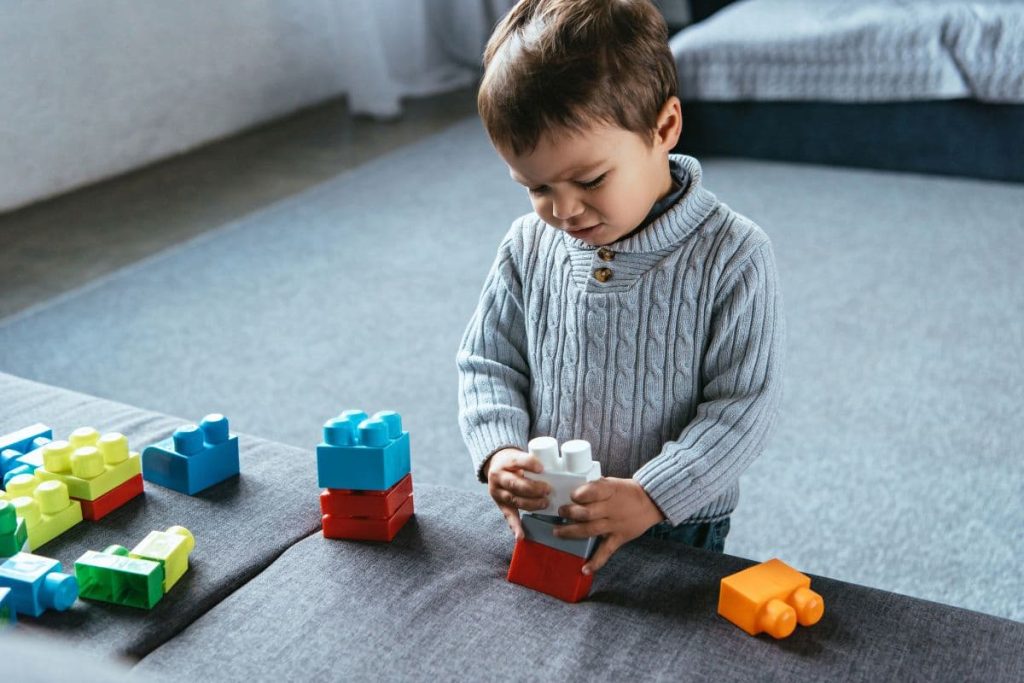As a parent, witnessing your toddler hitting himself when angry can be pretty distressing. You might wonder why such a tiny being is resorting to self-harm infliction. Let’s get into the world of toddlers, where big emotions are packed into little bodies, and explore compassionate solutions to manage this behavior.
KEY TAKEAWAYS:
- Understand and decode your toddler’s anger to provide a safe environment.
- Help them manage their emotions with attentiveness, understanding & self-soothing techniques.
- Partner with your child’s doctor for the underlying causes of the behavior & create a plan to manage it.
Decoding the Anger: Why Toddlers Hit Themselves

When toddlers are consumed by frustration or feel overwhelmed, they often resort to hitting themselves as a form of emotional expression. Given their limited communication skills at this developmental stage, this is their unique, albeit puzzling way of communicating their distress. Toddler hitting may also occur when they hit their head to grab attention or merely to explore their senses in their own little world.
To manage and eventually minimize this behavior, comprehension of these root causes is critical. Observing what instigates the toddler’s self-hitting and interpreting any recurring patterns can be quite helpful early intervention.
Mitigating self-hitting can be achieved by acknowledging their emotions and offering them a safe and supportive environment.
Unpacking Big Emotions in Little Ones
Toddlers are a bundle of emotions. When they struggle to verbalize these feelings, or express frustration, it can lead to frustration and anger, often manifesting as self-hitting. It’s akin to adults wanting to hit a wall when they’re annoyed. This self-harming behavior is their emotional outlet, their way of grappling with their feelings.
The case in point is when a 2-year-old hits themselves when they’re mad. It’s not an act of defiance but an expression of their frustration or a bid for attention. They simply haven’t learned how to use words to express their feelings yet.
The Cry for Attention: Navigating Attention-Seeking Behavior
The world of toddlers revolves around attention, and they crave it incessantly. When they fail to express their needs verbally, they resort to attention-seeking behaviors, such as self-hitting or when a child hits themselves. It’s their way of signaling that they’re upset and in need of assistance.
Our consistent reactions to self-hitting as caregivers can profoundly influence toddlers’ perception of their actions. Demonstrating attentiveness to their needs serves to underscore the unproductiveness of self-hitting as a means of managing emotions or communicating needs.
Consequently, this can help them interact with other kids positively. So, when your toddler starts hitting themselves, remember that they’re simply crying out for attention. Your calm and attentive response can really help your child navigate this phase effectively.
When Discomfort Strikes: Pain and Self-Hitting
Physical discomfort is another significant trigger for self-hitting in toddlers. The discomfort could range from:
- an ear infection
- teething pain in their gums
- hunger
- feeling cold
- thirst
In fact, any physical pain or discomfort can make toddlers resort to hitting themselves.
By proactively addressing their needs as parents, we can ensure their comfort before they turn to self-hitting, thereby preventing physical harm. Toddlers who struggle with sensory processing may hit themselves as a way to manage their sensory input. This behavior is an attempt to regulate their sensory experiences. Teaching them self-soothing techniques can help reduce this behavior.
Creating a Calm Oasis: Strategies to Prevent Self-Hitting

Prevention is the best cure, and this holds true in managing self-hitting behavior in toddlers. One example of the key strategies is childproofing your home. A childproofed home prevents potential injuries and creates a safe space for your toddler to explore, thereby reducing the chances of self-hitting.
Furnishing emotional support is another effective strategy, achievable by diverting your toddler’s attention with a beloved toy or an enjoyable activity. In the heat of the moment, when they are grappling with big emotions, a little distraction can help them refocus their energy positively.
Moreover, teaching them healthier, healthy ways to express their feelings can significantly help.
For instance, hitting a pillow, stomping their feet, or even deep breathing can help them manage their emotional reactions. If you’ve ever watched Daniel Tiger’s Neighborhood, you’d see they also teach kids this.
Childproofing with Purpose
Childproofing your home is more than just preventing injuries. It’s about creating a safe and conducive environment for your toddler to explore and grow. This involves securing potentially hazardous areas, like covering electrical outlets, babyproofing kitchen cabinets, and arranging furniture strategically.
Creating safe zones at home can significantly reduce self-hitting. These zones are devoid of any objects that might provoke them to hit themselves, ensuring their safety and happiness. By following their lead and encouraging creative activities, you can allow your toddler to explore and play even in a childproofed area.
Emotional Anchors: Deep Breathing and Comfort Objects
Teaching deep breathing techniques to your toddler can work wonders in managing their emotions. Fun deep breathing exercises like Hot Air Balloon Breathing or Dragon Fire Breaths can help them regulate their emotions and release tension.
Comfort objects or emotional anchors can also play a pivotal role in managing emotions and helping individuals self soothe. These objects provide a sense of security and comfort during stressful situations, reducing the likelihood of self-hitting.
Guiding Through the Storm: How to Intervene During an Episode
Intervening during a self-hitting episode requires a calm mind and a compassionate heart. Staying calm, redirecting your toddler’s energy, and validating their feelings can help manage such episodes effectively.
Offering a favorite toy, engaging them in a fun activity, or creating a calm environment can distract your child from self-hitting. Speaking calming words and providing children a comfort object can help soothe them during such episodes.
Staying Grounded: Remaining Calm and Collected
Your response to your toddler’s self-hitting behavior can significantly impact how they perceive their actions. Staying calm and collected during such episodes can provide a sense of stability and security to your toddler.
Remember, your toddler’s behavior is not a reflection of your parenting. Taking deep breaths, using self-regulation skills, and reminding yourself of this can help you stay calm and manage your reactions effectively.
The Power of Distraction: Redirecting Energy
Distraction is a powerful tool in managing self-hitting behavior. Engaging your toddler in a different activity or offering them a toy can quickly shift their attention away from hitting themselves.
Activities like playing with pudding, kinetic sand, or even stickers can keep them occupied. Distractions not only prevent emotions from escalating but also give the toddler a chance to calm down and refocus.
Validating Feelings Without Reinforcing Hitting
While it’s important to validate your toddler’s feelings, it’s equally crucial not to reinforce the hitting behavior. Reflecting their feelings, practicing positive beliefs, and labeling emotions can help them express themselves healthily.
Remember, showing empathy and understanding doesn’t mean to teach them that hitting is okay. It’s about acknowledging their feelings and teaching them healthier ways of expressing emotions.
Fostering Healthy Expression: Teaching Toddlers to Communicate

Communication plays a pivotal role in managing self-hitting behavior. Teaching your toddlers to communicate their emotions effectively can significantly further emotional regulation and reduce self-hitting.
Developing an emotional vocabulary and utilizing role-playing and social stories can cultivate healthier expression in toddlers as they child develop.
Building an Emotional Vocabulary
Building an emotional vocabulary is akin to equipping your toddler with a communication tool. When toddlers can recognize and label their emotions, they’re less likely to express themselves through self-hitting.
Words like “focused,” “bored,” “excited,” and “frustrated” can form a part of their emotional vocabulary. Through different activities and everyday conversations, you can help your toddler learn these words and express their feelings effectively.
Role-Playing and Social Stories
Role-playing can act as an emotional rehearsal for your toddler. By pretending to be different characters or acting out scenarios, they can learn to express their emotions and manage them effectively.
Social stories, on the other hand, can help them understand how to behave in different social situations. They’re like mini-guides to feeling, handling, and acting in various scenarios. Together, role-playing and social stories can make emotional learning an enjoyable experience for your toddler.
Celebrating Small Victories
Celebrating small victories, no matter how small, is crucial in your toddler’s emotional journey. When they can recognize and label their emotions or when they show gratitude, it’s a victory worth celebrating.
These celebrations can boost their confidence and reinforce positive behaviors. It’s like telling them, “Well done little boy! You’re learning to manage your big emotions.” And that’s a significant step in reducing self-hitting.
When to Seek Professional Help

Despite the effectiveness of these strategies in managing self-hitting behavior, there may be times when the intervention of a professional is necessary. Persistent or worsening behavior, signs of developmental delays, or suspicions of a more serious issue like autism spectrum disorder might necessitate a professional’s intervention.
Remember, it’s okay to seek help. Partnering with your child’s doctor can provide you with the appropriate support and guidance needed to manage this behavior effectively.
Beyond the Ordinary: Recognizing Red Flags
While occasional self-hitting is quite common in toddlers, certain red flags might indicate a deeper issue or developmental delay. Persistent self-hitting behavior or signs of developmental delays should not be ignored.
For instance, if your child keeps hitting their ear and displays other symptoms like fussiness, fever, or sleep disturbances, it might indicate an ear infection. These are signs that you need to seek professional help to ensure your toddler’s well-being.
Partnering with Your Child’s Doctor
If your toddler’s self-hitting behavior is causing you worry, consulting your child’s doctor should be your immediate course of action. They can check for any underlying medical or developmental issues related to your child’s self injury and behavior and suggest appropriate interventions in case a child hit is involved.
Your child’s doctor is your ally in this journey. By working together, you can address your concerns and develop a plan to manage your toddler’s self-hitting behavior effectively.
Summary
We’ve navigated through the world of toddlers, where big emotions often lead to self-hitting. We’ve unpacked these emotions, understood the cry for attention, and learned about the link between physical discomfort and self-hitting. We’ve also explored strategies to cope with and prevent self-hitting, including childproofing and emotional anchors, and discussed effective interventions during self-hitting episodes.
Remember, every toddler is unique, and so is their emotional journey. You can help your toddler navigate through their big emotions with patience, understanding, and the right strategies. Celebrate their small victories and remember, it’s okay to seek professional help when needed. You’re not alone in this journey; with each passing day, your little one is learning to manage their emotions better.
Frequently Asked Questions
Why does my toddler hit himself when he gets mad?
Your toddler may be hitting himself due to frustration, overstimulation, or an inability to communicate their needs. This behavior could also be a way for them to seek sensory experiences or self-soothe in response to their overwhelming emotions.
How long does toddler hitting phase last?
The toddler hitting phase typically lasts from 1-3 years old. Preschoolers may also hit, though the behavior will be less frequent.
How do you discipline a 2-year-old who hits?
When a 2-year-old hits, physically restrain them and remove them from the situation. Speak to them calmly and neutrally about why the behavior is unacceptable, then provide emotional support and redirect their energy. Give them a hug if appropriate, and place them in a time-out area for a few minutes to help them calm down.






